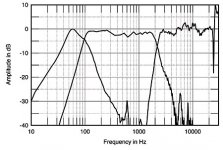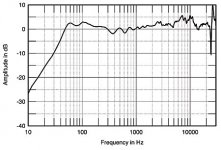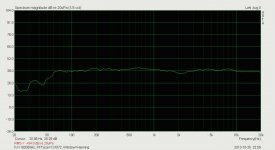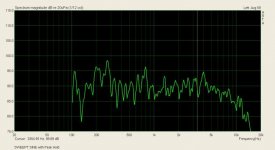thank you,
Is to create a flat signal cd to be played by the speakers...And I measure after with a micro with Arta for example ?
I like too the ears test 😀
Is to create a flat signal cd to be played by the speakers...And I measure after with a micro with Arta for example ?
I like too the ears test 😀
Hi fellows,
last night did some experiments after the give up of the cap in the 1 uf//10 homs serie tweeter genuine crossover of my Boston Acoustics Lynfield 400L? Which was a great sound quality...
The effect was a flater response for my ears and the brighness in treble was pad off a little... more than with the needled felt ant the two layers toilett paper... this last is great ninja tool because the speakers totaly deseaper with a more focused central sound area at my 11 feets (~3,5 meters). It is great because these speakers have asymetric faces with the tweeter insides (like many Proac). J. Hatkins, Steereophiles magasine, noticed with trhe 500L (sames speakers in two box with a littlr more bass for big rooms) it was better to put the speakers with tweeters rising outside and that the way my 400L are.
With the add of 1 hom in serie with the alone 10 hom, I was surprised because the brighness was already here but the mid bass had a pleasent more impact, with a little more bass presence but without problem of global balance... well the brighness was already here maybe more beamed than before with atentive listening !
then last night i try something i had in my toolbox : 15 homs... wow it's 50% more ! After the swap, it was very bad, the 1 uF was not connected !The medium was hushed...strange, the treble didn't suffer to much but the medium was "clearly" hushed with a more boomy prescence !
i was very sad, open a bootle of Bordeaux red wine, Boston acoustics was proof to give me the crossover of the 400L2 (i surmise to be better because it's the 2 in the rank and the 500L I surmise to have the better crossover because maid by Phil Jones...in two box for marketing maybe !)
But I connect the // 1 uf again with the new 15 homs resistors... kick in the *** after listening : better than ever and I'm not a beginner with listening (30 years of listening, I'M 44). The aplauds in concerts rooms are very acurate (I know than J Hiraga take care with that), and the brighness is over, tonal balance is better...wow ! Why Boston Acoustics techs did not notice that...electronic measure without listening ????? waste the little brother in relation to the more expansive big brother 500L flagship???? Don't know... but it's really better.
Have to try know the value than AllenB gave me for Lpad (none in tger genuine crossover maybe because the tweeter is FF, but too old now ?! have to show the driver unit to a second life FF Miami expert !
Hé I'm happy...it's very better, thank you fellow for the very good advice...sad in the same time, i lived with a speakers without knowing all its savoir faire ! have to speak to my wife !
Of course I continue the "au petits oignons" set up. Plan To tr the L-Pad given by AllenB (read its great crossover without measure thread) , try with 13, 14, and 16 homs , at 2 euros the pair of selfic Dayton cement resistor, it's worth to try.
Wow harmonica... Wow Andine Flut...
I have too try O,5 uF and 1,5uF vs the 1 uF genuine cap value...to deal with the density that I surmise to be changed a little (less with the 15 homs...not logical.)
Maybe the 3D is less acurate...more floating between R and L than before... don't understand why ? The crossover are second and forth orders, so pairs... no big problrmd of phase ?! What do you think about ?
last night did some experiments after the give up of the cap in the 1 uf//10 homs serie tweeter genuine crossover of my Boston Acoustics Lynfield 400L? Which was a great sound quality...
The effect was a flater response for my ears and the brighness in treble was pad off a little... more than with the needled felt ant the two layers toilett paper... this last is great ninja tool because the speakers totaly deseaper with a more focused central sound area at my 11 feets (~3,5 meters). It is great because these speakers have asymetric faces with the tweeter insides (like many Proac). J. Hatkins, Steereophiles magasine, noticed with trhe 500L (sames speakers in two box with a littlr more bass for big rooms) it was better to put the speakers with tweeters rising outside and that the way my 400L are.
With the add of 1 hom in serie with the alone 10 hom, I was surprised because the brighness was already here but the mid bass had a pleasent more impact, with a little more bass presence but without problem of global balance... well the brighness was already here maybe more beamed than before with atentive listening !
then last night i try something i had in my toolbox : 15 homs... wow it's 50% more ! After the swap, it was very bad, the 1 uF was not connected !The medium was hushed...strange, the treble didn't suffer to much but the medium was "clearly" hushed with a more boomy prescence !
i was very sad, open a bootle of Bordeaux red wine, Boston acoustics was proof to give me the crossover of the 400L2 (i surmise to be better because it's the 2 in the rank and the 500L I surmise to have the better crossover because maid by Phil Jones...in two box for marketing maybe !)
But I connect the // 1 uf again with the new 15 homs resistors... kick in the *** after listening : better than ever and I'm not a beginner with listening (30 years of listening, I'M 44). The aplauds in concerts rooms are very acurate (I know than J Hiraga take care with that), and the brighness is over, tonal balance is better...wow ! Why Boston Acoustics techs did not notice that...electronic measure without listening ????? waste the little brother in relation to the more expansive big brother 500L flagship???? Don't know... but it's really better.
Have to try know the value than AllenB gave me for Lpad (none in tger genuine crossover maybe because the tweeter is FF, but too old now ?! have to show the driver unit to a second life FF Miami expert !
Hé I'm happy...it's very better, thank you fellow for the very good advice...sad in the same time, i lived with a speakers without knowing all its savoir faire ! have to speak to my wife !
Of course I continue the "au petits oignons" set up. Plan To tr the L-Pad given by AllenB (read its great crossover without measure thread) , try with 13, 14, and 16 homs , at 2 euros the pair of selfic Dayton cement resistor, it's worth to try.
Wow harmonica... Wow Andine Flut...
I have too try O,5 uF and 1,5uF vs the 1 uF genuine cap value...to deal with the density that I surmise to be changed a little (less with the 15 homs...not logical.)
Maybe the 3D is less acurate...more floating between R and L than before... don't understand why ? The crossover are second and forth orders, so pairs... no big problrmd of phase ?! What do you think about ?
Last edited:
That 10 ohm resistor with 1uF cap stands out as a simple place to try tweaking things. Disconnecting the cap would reduce the higher frequencies. On the other hand if your issue is with the middle treble then increasing this cap might bring the upper treble into line if it is lacking, otherwise changing this resistance could be equally helpful in the ways already mentioned.
Hi AllenB,
have not receive the R2 (33 & 42 Homs) for L-pad yet.
With R1 10 homs increased to 15 homs and without the 1 uF// : it's better, more relaxing, more flater too but harchness is already here.
had a try with 15homs//0,5 uF it's worse than without the cap and worse than 10homs//1 uF.
I saw Stereophile test, and the peak seems to beyween at 5k & 10 khz with peaks at 7Khz & 9-10khz. The measures below is by Stereophile with the Lynfield 500L in anechoic chamber. The crossover of the 500 have the same value : 125hz & 2600 hz & the sames drivers. It's worth to try cotton fabric to pad of above 4Khz as said in the threads but afraid of too much attenuation after 10Khz...a little test will say if good or not.
I need help please, what do you think: is it a good one to pad off the DB with a resistor in serie in front of the first RC (10homs//1uF) ?
Or do I have to work more with R2 in a L-pad... maybe a shelving filter (pit notch)with f1 at 6K f at 8K and f2 at 10K (but don't know what i need to calculate it?)
the last picture is : Boston Acoustics 500L, anechoic response on tweeter axis at 50", averaged across 30° horizontal window.
Attachments
An externally hosted image should be here but it was not working when we last tested it.
My old speaker from the 80s with 5cm form on front baffle and with brick shells inside
no diffraction
no sound from the box wall
The speaker is a CS3 from KEF
great speaker for small money
It doesn't help...have already Kef 104/2, love the sound of old kef drivers...they did one like yours but with a bass box...They called it Kef 107.
I love my Kef but they don't have the astonishing transparent fast bass and transparency of the medium driver of the Boston ! And Well it's Not a Money Question (but if i have to change everything ! ) As I can see, you prefer litterature to music !
Want to know : which tweeter do you use ? T33 ?
I love my Kef but they don't have the astonishing transparent fast bass and transparency of the medium driver of the Boston ! And Well it's Not a Money Question (but if i have to change everything ! ) As I can see, you prefer litterature to music !
Want to know : which tweeter do you use ? T33 ?
Last edited:
KEF CS-3 use the tweeter T33
I forgot to mention that the crossover was modified with better components
later I upgrated to CS-9 with T52, B110 and B300, super speaker
philosophy, science and music is a good mix :-D
I forgot to mention that the crossover was modified with better components
later I upgrated to CS-9 with T52, B110 and B300, super speaker
philosophy, science and music is a good mix :-D
YES very good drivers unit than kef maid...
Have a very better result with 15 homs in serie without the C of the RC. So with 50% more R attenuation in treble (The 50% is my science side, for the Phi I'm still looking for, the presocratics books are usefull for bass trap or like the Husserls' ones...very large !)
I tried too the coton fabric t-shirt... not good.
But the treble is not as dark warm as the old beautifull kef ones !
Have a very better result with 15 homs in serie without the C of the RC. So with 50% more R attenuation in treble (The 50% is my science side, for the Phi I'm still looking for, the presocratics books are usefull for bass trap or like the Husserls' ones...very large !)
I tried too the coton fabric t-shirt... not good.
But the treble is not as dark warm as the old beautifull kef ones !
Last edited:
I Found a usefull adress : Parallel Notch Fliter Designer / Calculator 🙂
Well, I have not yet tools for measurements and try blind correction (the ears stay) with the Stereophile curve and the advices of the diya fellows. The acoustical way for notch seemed to me the most elegant way to not touch the phass of the crossover...but it seems to be a very random method
(the ears stay) with the Stereophile curve and the advices of the diya fellows. The acoustical way for notch seemed to me the most elegant way to not touch the phass of the crossover...but it seems to be a very random method
For example a parralell trap notch with f1=7K et F2=10k (see picture 2 above) we have for the // RLC : C= 30,2 mF, L= 0,4 mH and R=2,R
First try will be for the simplier // of the L-pad and finish last with the notch... and hope not witth the speakers (Why is it less simple to sell its speakers than its car ???
Do you know if a trap notch ha to be calculate at the listner position or at the same position in relation to the anechoic chamber measurement ?
Well, I have not yet tools for measurements and try blind correction
 (the ears stay) with the Stereophile curve and the advices of the diya fellows. The acoustical way for notch seemed to me the most elegant way to not touch the phass of the crossover...but it seems to be a very random method
(the ears stay) with the Stereophile curve and the advices of the diya fellows. The acoustical way for notch seemed to me the most elegant way to not touch the phass of the crossover...but it seems to be a very random methodFor example a parralell trap notch with f1=7K et F2=10k (see picture 2 above) we have for the // RLC : C= 30,2 mF, L= 0,4 mH and R=2,R

First try will be for the simplier // of the L-pad and finish last with the notch... and hope not witth the speakers (Why is it less simple to sell its speakers than its car ???

Do you know if a trap notch ha to be calculate at the listner position or at the same position in relation to the anechoic chamber measurement ?
Changing these components gives you a slow (gradual) slope. There is a sharp peak around 6kHz, it changes fast. This is a kind of problem that can make treble sound harsh. You might need a notch filter tuned to a high enough Q to fix this issue...or can it be fixed acoustically?...Is it only on axis and you can angle the speakers away?it's better, more relaxing, more flater too but harchness is already here.
Tank you AllenB
Do you think the notch band pass arround 6 to 10K at -3 db with the center of the trap at 5db with the passives components I gave above is enough ? Do I have to stay with the initial resistor in serie in the beginning of the filter and can i put the //RLC after the last series of caps (so between the filter and the tweeter ?)
The tweeters toe-in outside of the speakers' face to avoid beaming...but with a little inside (5%) position to the listener for the image. The resistor 15 homs add relaxing, i ask myself if the tweeter drivers add final distorsion or the peak (resonance) after 20K (the rise just before is the genuine AMD acoustical filter effect)
Do you think the notch band pass arround 6 to 10K at -3 db with the center of the trap at 5db with the passives components I gave above is enough ? Do I have to stay with the initial resistor in serie in the beginning of the filter and can i put the //RLC after the last series of caps (so between the filter and the tweeter ?)
The tweeters toe-in outside of the speakers' face to avoid beaming...but with a little inside (5%) position to the listener for the image. The resistor 15 homs add relaxing, i ask myself if the tweeter drivers add final distorsion or the peak (resonance) after 20K (the rise just before is the genuine AMD acoustical filter effect)
Without measuring, I would only be guessing. I like to measure, then sit down and simulate with what I have. Sometimes instead when I'm producing a first crossover for something I'll instead sit down with a microphone and a soldering iron. Anyway..I'll give you these thoughts.
You can probably put this filter in parallel with the tweeter. Often a tweeter crossover doesn't have a high enough source impedance for this but yours would seem to be OK. The RLC will be in series (with each other) and parallel to the driver. It is a band stop filter not a band pass filter.
It may be difficult to get the filter sharp enough at the edge while not taking too much off the level. You might want to try just fixing a smaller band (eg: the lower frequency half of the peak) as this could make the response more smooth in the 5-6k region. This will be more important than what happens past 10k.
You can probably put this filter in parallel with the tweeter. Often a tweeter crossover doesn't have a high enough source impedance for this but yours would seem to be OK. The RLC will be in series (with each other) and parallel to the driver. It is a band stop filter not a band pass filter.
It may be difficult to get the filter sharp enough at the edge while not taking too much off the level. You might want to try just fixing a smaller band (eg: the lower frequency half of the peak) as this could make the response more smooth in the 5-6k region. This will be more important than what happens past 10k.
Hi allenB
Thank you for advises. I understand you mean a serie peak attenuator instead of a band notch filter... i have to found a calculator... (mathematic are far away...)
It seems I have to choose between L-Pad or serie Peak attenuator...maybe L-pad + band-notch ! Have now 2 x 33 homs to have a first try to L-Pad with two R1 value 10 ohms & 15 ohms
do you know if minimum impedance seen by amp can be fall with more R in serie or is it the opposite. Or R is not a global atttenuator if // with a L or C or both (//RLC in serie with signal = band notch) ?
Thank you for advises. I understand you mean a serie peak attenuator instead of a band notch filter... i have to found a calculator... (mathematic are far away...)
It seems I have to choose between L-Pad or serie Peak attenuator...maybe L-pad + band-notch ! Have now 2 x 33 homs to have a first try to L-Pad with two R1 value 10 ohms & 15 ohms
do you know if minimum impedance seen by amp can be fall with more R in serie or is it the opposite. Or R is not a global atttenuator if // with a L or C or both (//RLC in serie with signal = band notch) ?
Inverted polarity with the tweeters !
As the spreakers were bought in second hand already tweaked by the first owner (he changed only the wires !), I tried to inverse the polarity with the tweeters because i read at stereophile than the 500l have a crossover like that on the microphone measures....
It's better, but not yet tried with the genuine RC serie value of the tweeter crossover (1à ohms//1 uF)...with the 15 ohms inverted polarity...it's better, harchness at deseapper more than 15 ohms with normal polarity!
is it possible to have a second electrical order for the mid with a 4° order inverted polarity for the tweeter ? Or is it just chance ?
Yes it's more a warmer sound...more relaxing too...big progress...believe your ears !
As the spreakers were bought in second hand already tweaked by the first owner (he changed only the wires !), I tried to inverse the polarity with the tweeters because i read at stereophile than the 500l have a crossover like that on the microphone measures....
It's better, but not yet tried with the genuine RC serie value of the tweeter crossover (1à ohms//1 uF)...with the 15 ohms inverted polarity...it's better, harchness at deseapper more than 15 ohms with normal polarity!
is it possible to have a second electrical order for the mid with a 4° order inverted polarity for the tweeter ? Or is it just chance ?
Yes it's more a warmer sound...more relaxing too...big progress...believe your ears !
Last edited:
The filter will only affect a band of frequencies. If the resistance used is smaller, then the impedance will drop at these frequencies. With the L and C these will determine the width of the band. Your series resistor (with the 1uF capacitor) should prevent the total impedance from dropping too low if you use a smaller value resistor in the notch filter.do you know if minimum impedance seen by amp can be fall with more R in serie or is it the opposite. Or R is not a global atttenuator if // with a L or C or both (//RLC in serie with signal = band notch) ?
Well... it's a difficult task.
the inverted polarity with tweetr match with the goal to avoid brighness but I think it's not the genuine layout because there is a phase problem : the 3D stage were gone (tried with the genuine conf with the RC and without with the 15 ohms in serie i like and without the cap of the RC with the genuine 10 ohms).
15 ohms alone is the better, quality increase without a doubt, but a certain energy can be always heard (energy peak that is difficult to identify without measure but it's tyhe goal of the thread : what can be done here with minors change and general knowledge posted)
1O ohms alone without the cap in the RC is better than with RC but not than the 15 ohms alone.
Just try R2 with 33 ohms in L-Pad (// to the driver after the last stage of the 4° order tweeter crossover with the R1 serie 10ohms at the beginning at the stage (so with the caps & self between them) : It's better, warmer than R1 alone (10 ohms in serie with + signal).
Progress. Interresting. Tommorow continue L-Pad with R1=15 ohms and beginn the notch experiment. Global spent is for the moment 40 euros with the band trap notch. It's 2% of the cost of my speaker in second hand but worth to try, experiment, learn something and maybe sucess.
the inverted polarity with tweetr match with the goal to avoid brighness but I think it's not the genuine layout because there is a phase problem : the 3D stage were gone (tried with the genuine conf with the RC and without with the 15 ohms in serie i like and without the cap of the RC with the genuine 10 ohms).
15 ohms alone is the better, quality increase without a doubt, but a certain energy can be always heard (energy peak that is difficult to identify without measure but it's tyhe goal of the thread : what can be done here with minors change and general knowledge posted)
1O ohms alone without the cap in the RC is better than with RC but not than the 15 ohms alone.
Just try R2 with 33 ohms in L-Pad (// to the driver after the last stage of the 4° order tweeter crossover with the R1 serie 10ohms at the beginning at the stage (so with the caps & self between them) : It's better, warmer than R1 alone (10 ohms in serie with + signal).
Progress. Interresting. Tommorow continue L-Pad with R1=15 ohms and beginn the notch experiment. Global spent is for the moment 40 euros with the band trap notch. It's 2% of the cost of my speaker in second hand but worth to try, experiment, learn something and maybe sucess.

Hi,
Last experiments maid:
- 11,12,13 ohms alone or with the 1 uf cap : bad ; better without cap.
-L-Pad with 33 homs for R2 : R1 = 10,11,13,15 : bad
- large bandpass notch (without the genuine 10 ohms//I uF in serie) = L:2,2 mH // 8,7 uF MKT //2,7 ohms in serie : bad : plastic voice... the notch is 5K to 12 K
- 14 or 15 ohm serie without the 1 uf Cap : is the better, improvement : this is the set up Boston Acoustic 400L & Maybe 500L have to try :
Give up the 10 ohms//1 uF for 15 ohms, cement one for the selfic effect. mechanical give shy result as the default to be change is too big for that. Toilett paper add a little warmer result but don't fight against the brighness and th energy peak in the treble.
thank you all for your testimonies.
i stop here
Last experiments maid:
- 11,12,13 ohms alone or with the 1 uf cap : bad ; better without cap.
-L-Pad with 33 homs for R2 : R1 = 10,11,13,15 : bad
- large bandpass notch (without the genuine 10 ohms//I uF in serie) = L:2,2 mH // 8,7 uF MKT //2,7 ohms in serie : bad : plastic voice... the notch is 5K to 12 K
- 14 or 15 ohm serie without the 1 uf Cap : is the better, improvement : this is the set up Boston Acoustic 400L & Maybe 500L have to try :
Give up the 10 ohms//1 uF for 15 ohms, cement one for the selfic effect. mechanical give shy result as the default to be change is too big for that. Toilett paper add a little warmer result but don't fight against the brighness and th energy peak in the treble.
thank you all for your testimonies.
i stop here
Pfff I continue,
great improvement : less peak energy, more natural sound, better articulation, warmer...come in mind
I come back to the 1O ohms resitor but non inductive. Give up the // 1 uF.
But just maid a Parralel bandpass notch after measurement. It showed something borring at 7 khz as said at Stereophile with the Boston Lynnfield 500L (same drivers but 2 cabinets... mine is a standalone cabinet)
Well, the Notch have a "short" bandpass -2.5db 6000 to 8500 hz, centered around 7000 hz.
0,05 mH//2,7 ohms//4.9 uf (3.4 SCR MKP-Sn//0.478 MKP Orange drops 716J // 0,1 Multicap MIT RTX)
the caps are choose for their quality to lower the harchness, it could be a MKT + the MIT RTX too... but details (that I can hear). The resistor here is cement to padd down a little the great pristin non inductiv 10 ohm from Mundorf.
Have to try 3.3 ohms cement vs non inductive. Have to persist with foam on the tweeter, now i know with the HOM in the Horn theory than open reticuled FOAM around 30 PPI (is the good word ?) can be find in Aquarium store...without the red fish on the speaker ! I'm still turning around this speaker !
First picture : silent room at 4 AM with own calib file for ECM-8000 give this flated FRD. Second is the 400L in my living room with log sweep sine from audiocheck website.
great improvement : less peak energy, more natural sound, better articulation, warmer...come in mind
I come back to the 1O ohms resitor but non inductive. Give up the // 1 uF.
But just maid a Parralel bandpass notch after measurement. It showed something borring at 7 khz as said at Stereophile with the Boston Lynnfield 500L (same drivers but 2 cabinets... mine is a standalone cabinet)
Well, the Notch have a "short" bandpass -2.5db 6000 to 8500 hz, centered around 7000 hz.
0,05 mH//2,7 ohms//4.9 uf (3.4 SCR MKP-Sn//0.478 MKP Orange drops 716J // 0,1 Multicap MIT RTX)
the caps are choose for their quality to lower the harchness, it could be a MKT + the MIT RTX too... but details (that I can hear). The resistor here is cement to padd down a little the great pristin non inductiv 10 ohm from Mundorf.
Have to try 3.3 ohms cement vs non inductive. Have to persist with foam on the tweeter, now i know with the HOM in the Horn theory than open reticuled FOAM around 30 PPI (is the good word ?) can be find in Aquarium store...without the red fish on the speaker ! I'm still turning around this speaker !
First picture : silent room at 4 AM with own calib file for ECM-8000 give this flated FRD. Second is the 400L in my living room with log sweep sine from audiocheck website.
Attachments
Last edited:
Have you opened the tweeter? Dampened with felt under the dome? Often times this area is neglected and is a source of this issue, as are suspension issues, where PVA can be applied sparingly.
hi Greebster, hi all
I had courage today and tried for the first time to open the tweeters, easier than I thought. The golden screws are used to give the signal to the driver. diameter of the alum dome is 2.5 cm and 3 cm took on the middle of the round rubber. it climbs at 30 khz but a mechanical notch trap makes a deep at something 21000 khz....
After some sucees with a passive short notch trap at 4000 it's better but some siblings stay; john Atkison measure on the Boston Lynfield 500 L (same drivers, same high pass Xover)) a flat peak between 5000 to 10000...
Is there a very little medical coton between the foam damping cone and the aluminium cone can paddle off some peaks between 5000 to 10 000 hz ? Maybe i can try to put a verry little peach of fabrik in the peak of the foam dome where the hire frequencies are supposed to beam from the dome side above ?
No danger with heat ? Bad idea ? I yhink there is no place for someting else than cotton or thin fabric sheet... Its impossible to have an idea of the gap between the dome and the foam dome absorber ! But I suppose 1 mm or 2 mm max !
Do I have to change the ferrofluid in the round interstice of the magnet where the aluminized dome repose ? The color of the fluid took on the interstice has a rusted color and is viscous when i touch it between my fingers: not fluid but i suppose this is normal with Ferrofluid ? It's far less fluid than food oil e.g.
On the last photograph, you can see the magnett with its circular interstice : it's a strong Neodyn which is able to move a 3.5" mid but here it's for a 1". Photograph n° 5 is inside the dome and the magnet with its icircular interstice where the aluminium cone is posed. You can see the reticulated foam dome for absorption... no chamber inside : it's plane beneath it...
Bad idea ?
Attachments
-
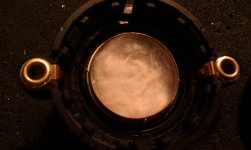 IMAG1098.jpg817.2 KB · Views: 108
IMAG1098.jpg817.2 KB · Views: 108 -
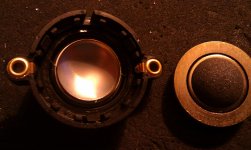 IMAG1097.jpg386.8 KB · Views: 118
IMAG1097.jpg386.8 KB · Views: 118 -
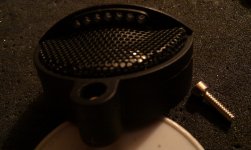 IMAG1096.jpg385.1 KB · Views: 95
IMAG1096.jpg385.1 KB · Views: 95 -
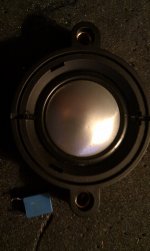 IMAG1095.jpg911.8 KB · Views: 176
IMAG1095.jpg911.8 KB · Views: 176 -
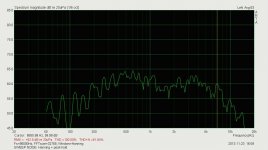 Log Sweep Sine Boston Lynfield 400L at home.JPG86.8 KB · Views: 182
Log Sweep Sine Boston Lynfield 400L at home.JPG86.8 KB · Views: 182 -
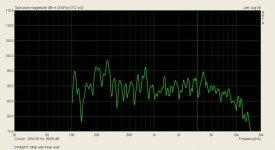 sweep sine wth peak hold in home room.jpg64.3 KB · Views: 181
sweep sine wth peak hold in home room.jpg64.3 KB · Views: 181 -
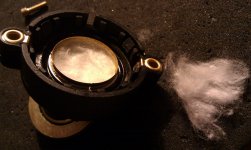 IMAG1109.jpg392.8 KB · Views: 101
IMAG1109.jpg392.8 KB · Views: 101
Last edited:
- Status
- Not open for further replies.
- Home
- Loudspeakers
- Multi-Way
- acoustical filter for tweeters ?
